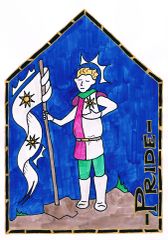Pride
The Path of Pride
Some may believe that Pride is simply senators in fine clothing praising the qualities of their Nation, but this is only a tiny part of the path. National Pride is, quite rightfully, important to many citizens and is the reason for the creation of the egregores. Yet the Virtue of Pride exists to inform the small parts of life as much as the large. From the servant who keeps their mistress’ cups clean, to the craftsman who holds all their work to the same high standard, to the general who remembers the name of every soldier who died under their command – all demonstrate Pride and know what it is that they serve and strive for.
Guidance on the Path
Through meditation on the auras of Pride, and close study of the stories of paragons and exemplars, the priests of the Way have gleaned insight into the heart of the virtue and how best to pursue it. There are collections of parables, tales, sayings and teachings that distill this for Imperial citizens to learn from. The following are a handful of teachings and sayings deemed to be essential to understanding the path:
- Pride conveyed by words alone is vain boasting; proclaim it by how you conduct every part of your life.
- Do not be complacent; ever strive for excellence in that of which you are proud.
- Embrace your past; never be ashamed of it.
- The Virtuous inspire others to greatness; they do not demean them.
- Despise the half-hearted, the uncommitted and the pretender.
Paragons and Exemplars
Across history, the paragons and exemplars of Pride have been amongst the easiest to identify for they are, by nature, rarely reclusive and withdrawn. Recognised paragons and exemplars of Pride include:
- The legendary paragon Kethry of the Kesh kept her peoples' ways alive and ultimately inspired the conquering nation to embrace them.
- The paragon Richilde inspired the people of the Empire to celebrate their culture and history, and was the first paragon recognised in the modern era.
- The Highborn paragon Lepidus kept the spiritual heart of his nation alive during the dark days of the Patrician Council's corruption.
Symbols of Pride
Priests of Pride teach that the best symbol of the virtue is the open display of whatever it is that the pilgrim is most proud of. The flag and the banner are ways of displaying such symbols, as is the livery of a Marcher household, or the heraldry of a noble or Noble_house in Dawn.
As a more unified symbol of the virtue itself, rather than of the individual's personal Pride, the Imperial Synod often favours the sun. The sun shines brightly, without shame, open for all the world to see. By so doing, it allows others to see as well - and while it may occasionally be occluded by clouds, when the clouds pass the sun's light is undiminished.
In Wintermark, the eagle, the heron, and the swan all symbolise Pride. The eagle is also a popular symbol of the virtue in Varushka where it is joined by the deer. Some magicians use the rune of Majesty, Feresh, which represents glorious splendor, to symbolise Pride. These magicians point to the way that Feresh only enhances attributes that are already present as a particularly telling parable about the nature of Pride.
During their Spring festival, the Urizen represent the virtue of Pride with pink blossoms.
Further Reading
- You can learn about the various spiritual roleplaying effects created by priests dedicated to Pride here.
- You can learn about the skills that priests can use to inspire the virtue of Pride here.
